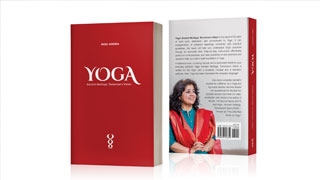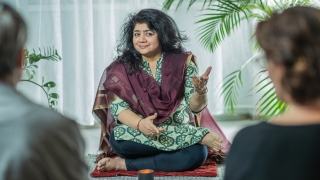
Login

For your mind
Latte Asana with a dash of Mantra Masala!
![]() 3 minutes
•
10/10/22
3 minutes
•
10/10/22
Yoga and Ayurveda are becoming a weird mix — like Turmeric Latte Asana. There is a lack of integration, a ton of dilution, a good amount of appropriation, and plenty of misunderstandings.
My top three reasons why this is happening:
1) Yoga and Ayurveda are taught in isolation. For example, after one does a few hundred hours of Yoga Training, only then, and only a handful of graduates lean toward Ayurveda. What is a must as a foundation, becomes optional. If Yoga + Ayurveda were taught together from the beginning, there would be integration. The abstract concepts of Gunas, Doshas, Marma, Samkhya, etc. will benefit from the practical, tangible, and experiential aspect of Yoga practices. The theoretical studies tend to overwhelm and demotivate the mind of beginners when there is an absence of a practical counterpart.
2) Yoga and Ayurveda are taught in extremes.
Dilution and Extremes in Yoga: Yoga either becomes all about asana/workout or all about Sanskrit, Vedic/Tantrika texts and a scholarly approach.
Dilution and Extremes in Ayurveda: Ayurveda either gets lost in simplification of using turmeric, having a Khichadi diet, Chai Tea Latte on-the-go, or frequent visits to the closest curry house or goes into extremes of signing up for detoxes, learning how to read pulse (takes about 10,000 hands and a decade worth of practice to reach somewhere in it), or accumulating texts like Charaka Samhita, etc. and doing a Doctorate.
Here is my take…extremes have never benefited the masses. In fact it has only made these ancient philosophies either misunderstood, misinterpreted, or steered away from out of fear and overwhelm. What is generally learned over decades is taught and expected to be digested in a matter of few hundred hours or over a weekend course.
3) Sans common sense. Everyone wants a formula, technique, and a magic wand. Just tell me my dosha, a combination of herbs, and a tailored yoga practice. However, this is not only limiting but also takes away the heart of the practice, which is to build awareness. Imagine a situation in which the Yoga seeker learns how to take a pause, check in with the sensations, koshas, and dosha, feel what seems out of harmony and chooses the practices accordingly. What is common sense has become rocket science. Practice has become a monologue compromising of a list of things to do robotically.
Learn to integrate, actualize, and live what you have learned, otherwise all knowledge is simply clutter and a mindless hoarding, only beneficial for verbal karate (argumentativeness). In 20 years of my work as a Yoga Educator, sincere seeker, Yoga and Ayurveda therapist, I have seen this seemingly clear gap between Yoga and Ayurveda that needs to be bridged. It will make practitioners of either philosophy thrive, feel empowered and understand themselves in the light of fullness.
Ways to study Ayurveda with me:
- READ: SOMA 100 Heritage Recipes for Self-Care. Get hard copy or e-book
- LISTEN: Podcast episode on Yoga and Ayurveda here
STAY IN TOUCH
Start your FREE subscription to Indu Arora's newsletter to get more on Yoga and Ayurveda here
Say hello on Instagram
Subscribe to my Youtube Channel.


Why Study Chakras?
Awareness of the subtle, intangible, and all-pervading is what allows a practitioner to reach deeper states of consciousness. With each moment that we strengthen our practice with concentration on the chakras, we are that much closer to the state of Yoga.

Q and A of the week - No.6
The practice of asanas transforms as we go deeper, from physical to mental to pranic realms. There are layers to the same practice. Here is a question and a deep exploration of Veerasana / Warrior pose